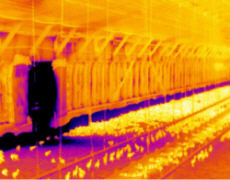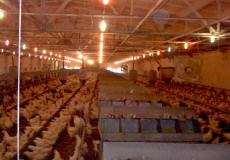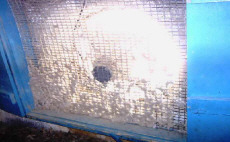



Poultry Ventilation: Breeder House Ventilation Principles
By Aviagen. With this article Aviagen is continuing the series about the successful management of Ross flocks. Here we discuss effective ventilation of the breeder house.The primary goals of effective ventilation are to remove excess heat and moisture, provide oxygen while removing harmful gasses maintaining air quality in the house. When house ventilation is set up incorrectly the systems can struggle to achieve the primary goals and performance and health status of the breeder flock will all suffer.
The design and set up of the ventilation system should take into account the external environment. In the CIS region the most appropriate ventilation is usually provided by a conventional fan and inlet system. However during hot weather tunnel ventilation can be an invaluable aid to bird management.
 |
| Pic.1. Cold spot near leaking fan shutter. Picture courtesy of M.Czarick, UGA |
The basis for good control of the environment firstly is to ensure that air only enters the house through the inlets. It is important that fresh (cooler) air coming into the house is well mixed with the stale (warmer) air already there. One of the common problems in ventilating houses that are poorly sealed is low static pressure. This causes the incoming air to travel too slowly, which means cold heavy incoming air (especially in winter time) drops to the floor, dumping water vapour in the litter as it does so. If the house is not sealed, air will enter the shed footers, around doors, Poor ventilation management shows itself in pockets of dead air, drafts, cold spots, or hot spots (caused by poor house insulation); it will cause poor flock performance and may even cause mortalities (Pic. 1).
To avoid a dropping air stream in very cold weather, static pressure may be increased up to +10% from standard to increase air speed. Vent box inlets are available which are automatically adjusted by computer which monitors static pressure.
All thermometers or thermal sensors or thermostats need to track temperature at bird level. What matters is what is being experienced by the birds, not by the manager or even by a thermometer; especially one mounted four feet above bird level.
 |
| Pic. 2. Laying nests placed across the direction of airflow will limit the efficiency of tunnel ventilation' |
A common ventilation error is that managers are often nervous of ventilating younger flocks particularly during cold and humid weather. It's important to realise that during cold weather moisture coming into the house with outside air and the amount of house heat lost during minimum ventilation is insignificant compared with the benefits gained in bird performance. Cold air can't hold much moisture, and as it is warmed by good mixing with the house air its relative humidity will drop. This enables the ventilation air flow through the house to absorb and exhaust excess moisture and harmful gases. Thus we can and must operate minimum ventilation rates even during the harshest of external climates.
Another common mistake is seen in operating transitional or tunnel ventilation modes. In judging the time and need to switch to tunnel ventilation, we must keep the wind-chill effect in mind. Air speed in tunnel ventilated houses is fast enough to cause significant wind chill. This is completely inappropriate for young breeding stock, or when the outside temperatures are cold. If we are switch into tunnel mode inappropriately, the birds will experience a drop in the "apparent temperature," which may be quite a bit lower than the thermometer reading. When birds are young and sensitive to wind-chill, the effective temperature drop will feel like a blast of cold air and be difficult for them to cope with. Equally in hot weather and for mature birds, the wind chill effect can help keep the birds comfortable and laying normally.
One common problem with operating tunnel ventilation is when all the tunnel fans are in use but they are struggling to achieve the required air velocity of 2,5 meter per second at bird level over the whole house (which is needed for most effective wind-chill cooling).
The most often reasons for that are the following:
- Air entering the shed from points other than the designated air inlet at the end opposite to that of the fans
- Inlet area is too small for the number of fans running (static pressure too high and fans struggle to move volume of air) or fan capacity is not enough - static pressure drops too low.
- Having any obstructions to airflow being placed directly in the airstream. For example, pen barriers, sealing cross-beams or nest boxes orientated perpendicular to airflow (Pic. 2).
- If fans blades, shutters, bird protective nets or cooling pads are dirty, or fan belts are worn or loose, the air-moving capacity of fans can be reduced by 30%. As a result the static pressure will drop and airflow will be reduced (Pic. 3).
 |
| Pic. 3. Dirty bird-protective net resists airflow and strains fan capacity. |
It is useful to remember that pen partition fences with small mesh size and light baffle hoods can also decrease static pressure in the house as they impact on the efficiency of the fan and can reduce exhaust fan performance giving the illusion that the house is less air tight than it really is. Pay your attention to this, when assessing the house.
Integrated electronic control systems now make the management of ventilation easier, since they can automatically switch modes and adjust ventilation rates as conditions change. It is important to remember the smartest controller is not infallible, and must be monitored. Even more important, the controller settings themselves must be determined by a knowledgeable stockman. There is just no substitute for a good poultry man who is in the house frequently, watching the birds and making the control adjustments they need for best performance.









